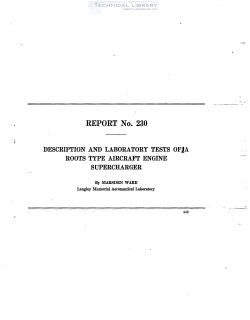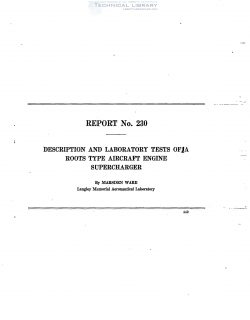naca-report-230

- Version
- 195 Downloads
- 1.19 MB File Size
- 1 File Count
- August 25, 2016 Create Date
- August 25, 2016 Last Updated
National Advisory Committee for Aeronautics, Report - Description and Laboratory Tests of a Roots Type Aircraft Engine Supercharger

This report describes 8. Roots type aircraft engine supercharger and presents the results of
some tests made with it at the Langley Field laboratories of the National Advisory Committee
for Aeronautics. The supercharger used in these tests was constructed largely of aluminum,
weighed 88 pounds and was arranged to be operated from the rear of a standard aircraft engine
at a speed of 1% engine crankshaft speed. The rotors of the supercharger were cycloidal in
form and were 11 inches long and 9% inches in diameter. The displacement of the super-
charger was 0.51 cubic feet of air per revolution of the rotors.
The supercharger was tested in the laboratory, independently and in combination with a
Liberty-12 aircraft engine, under simulated altitude pressure conditions in order to obtain
information on its operation and performance. During an investigation of the influence on the
operation of the engine of various types of air-duct connections between the supercharger and
the engine, the supercharger was subjected to considerable rough treatment, which it endured
very Well, so that it seems apparent that the supercharger could well endure service handling.
By the proper proportioning of the air-duct system, the engine would operate at all speeds
as smoothly and free from vibration as the normal engine.
From these tests it seems evident that the Reots blower compares favorably with other
compressor types used as aircraft engine superchargers and that it has several features that
make it particularly attractive for such use.
Since the density of the atmosphere decreases continuously with increase in altitude, the
power developed by the normal aircraft engine decreases as its altitude of Operation is increased
to such an extent that the power develoPed at 20,000 feet is less than 50 per cent of that
deveIOped at sea level. Analyses have shown that this diminution in power can be prevented
or at least reduced materially by supercharging, and applications of superchargers to service
airplanes have resulted in marked increases in airplane performances.
| File | Action |
|---|---|
| naca-report-230 Description and Laboratory Tests of a Roots Type Aircraft Engine Supercharger.pdf | Download |
Comment On This Post